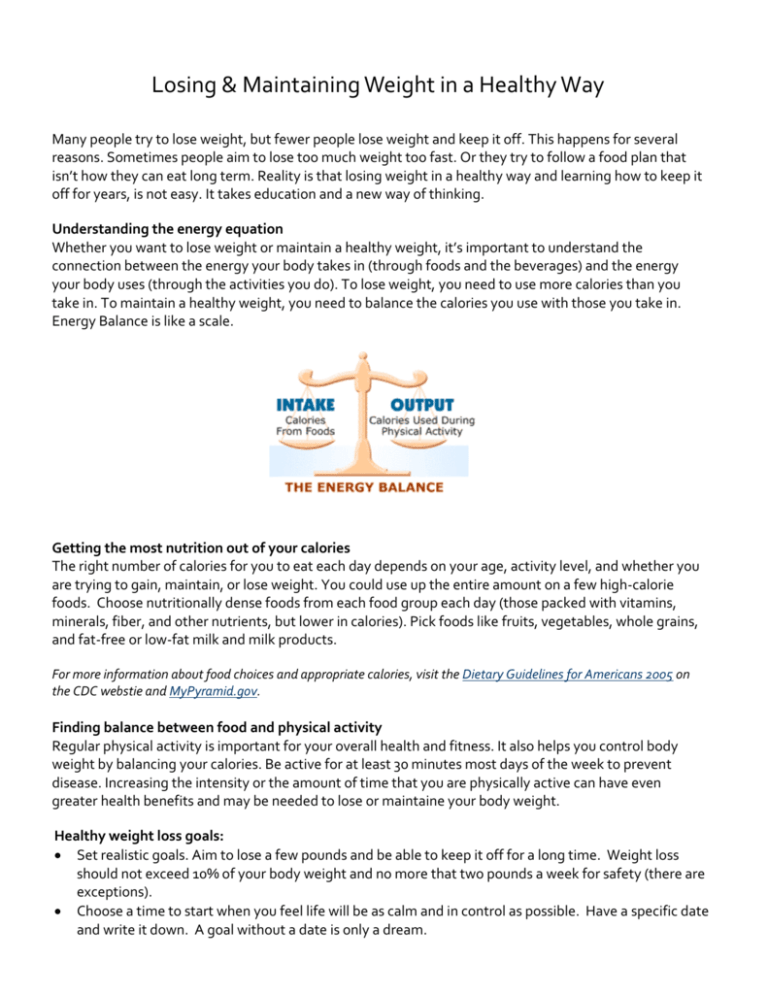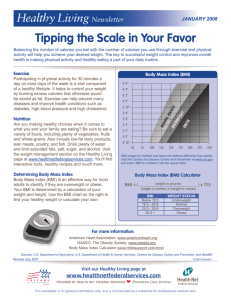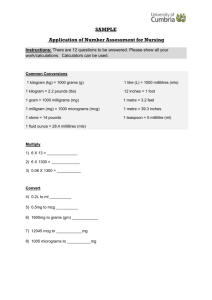Healthy weight loss goals
advertisement

Losing & Maintaining Weight in a Healthy Way Many people try to lose weight, but fewer people lose weight and keep it off. This happens for several reasons. Sometimes people aim to lose too much weight too fast. Or they try to follow a food plan that isn’t how they can eat long term. Reality is that losing weight in a healthy way and learning how to keep it off for years, is not easy. It takes education and a new way of thinking. Understanding the energy equation Whether you want to lose weight or maintain a healthy weight, it’s important to understand the connection between the energy your body takes in (through foods and the beverages) and the energy your body uses (through the activities you do). To lose weight, you need to use more calories than you take in. To maintain a healthy weight, you need to balance the calories you use with those you take in. Energy Balance is like a scale. Getting the most nutrition out of your calories The right number of calories for you to eat each day depends on your age, activity level, and whether you are trying to gain, maintain, or lose weight. You could use up the entire amount on a few high-calorie foods. Choose nutritionally dense foods from each food group each day (those packed with vitamins, minerals, fiber, and other nutrients, but lower in calories). Pick foods like fruits, vegetables, whole grains, and fat-free or low-fat milk and milk products. For more information about food choices and appropriate calories, visit the Dietary Guidelines for Americans 2005 on the CDC webstie and MyPyramid.gov. Finding balance between food and physical activity Regular physical activity is important for your overall health and fitness. It also helps you control body weight by balancing your calories. Be active for at least 30 minutes most days of the week to prevent disease. Increasing the intensity or the amount of time that you are physically active can have even greater health benefits and may be needed to lose or maintaine your body weight. Healthy weight loss goals: Set realistic goals. Aim to lose a few pounds and be able to keep it off for a long time. Weight loss should not exceed 10% of your body weight and no more that two pounds a week for safety (there are exceptions). Choose a time to start when you feel life will be as calm and in control as possible. Have a specific date and write it down. A goal without a date is only a dream. Keep a log of when and what you eat and drink. Keep honest food records for about a week. Use these records to your goals. These food goals should be small changes you can easily make to your existing food habits. Don’t look for a magic pill diet. They don’t exist. Base eating habits on what you found out in your food log. Be ready to change your food habits (and perhaps your family’s food habits) for good. Say goodbye to some of your unhealthy habits and food choices. Keep an activity log. How much exercise do you get? How can you work more of it into your day? Reward and acknowledge your efforts Tips for being more active Walk, cycle, jog, skate, etc., to work, school, the store, or place of worship. Park the car farther away from your destination. Get on or off the bus several blocks away. Take the stairs instead of the elevator or escalator. Play with children or pets. Take walking breaks or do desk exercises. Perform gardening or home repair activities. Avoid labor-saving devices. Turn off the self-propel option on your lawn mower or vacuum. Exercise while watching TV (for example, use hand weights, home equipment or stretch). Dance to music. Keep a pair of comfortable walking/running shoes in your car and office. You'll be ready for activity wherever you go! Make a weekend walking group a habit. Begin by choosing activities you enjoy the most. By choosing activities you enjoy, you'll be more likely to stick with them. Starting out slowly. Gradually build up the time spent doing the activity by adding a few minutes every few days or so until you can comfortably perform a minimum recommended amount of activity (30 minutes per day). As the minimum amount becomes easier, gradually increase either the length of time performing an activity or increase the intensity of the activity, or both. Vary your activities, both for interest and to broaden the range of benefits. Explore new physical activities. What is BMI? Body Mass Index (BMI) is a number calculated from a person’s weight and height that is used as a screening tool to identify possible weight problems for adults. . It does not measure body fat directly, but is a reliable source that correlates to direct measures of body fat (such as underwater weighing). Additionally, BMI is an inexpensive and easy-to-perform method of screening for weight categories that may lead to health problems. Calculating BMI is one of the best methods for population assessment of overweight and obesity and allows people to compare their own weight status to that of the general population. Calculation of BMI BMI is calculated the same way for both adults and children. The calculation is based on the following formulas: Measurement Units Kilograms and meters (or centimeters) Formula and Calculation Formula: weight (kg) / [height (m)]2 With the metric system, the formula for BMI is weight in kilograms divided by height in meters squared. Since height is commonly measured in centimeters, divide height in centimeters by 100 to obtain height in meters. Example: Weight = 68 kg, Height = 165 cm (1.65 m) Calculation: 68 ÷ (1.65)2 = 24.98 Pounds and inches Formula: weight (lb) / [height (in)]2 x 703 Calculate BMI by dividing weight in pounds (lbs) by height in inches (in) squared and multiplying by a conversion factor of 703. Example: Weight = 150 lbs, Height = 5’5” (65") Calculation: [150 ÷ (65)2] x 703 = 24.96 Interpretation of BMI for adults For adults 20 years old and older, BMI is interpreted using standard weight status categories that are the same for all ages and for both men and women. For children and teens, on the other hand, the interpretation of BMI is both age- and sex-specific. The standard weight status categories associated with BMI ranges for adults are shown in the following table. BMI Weight Status Below 18.5 Underweight 18.5 – 24.9 Normal 25.0 – 29.9 Overweight 30.0 and Above Obese Sources: CDC, Diabetes.org, WebMd







